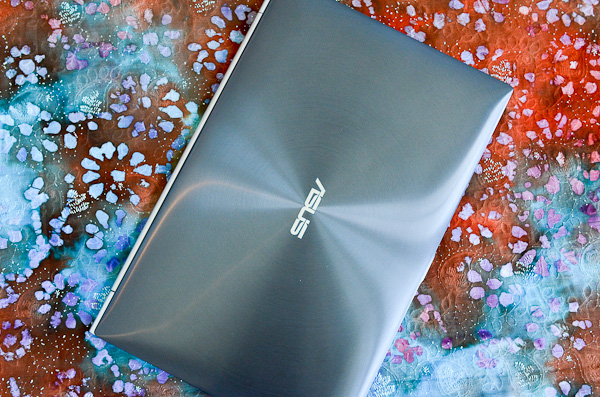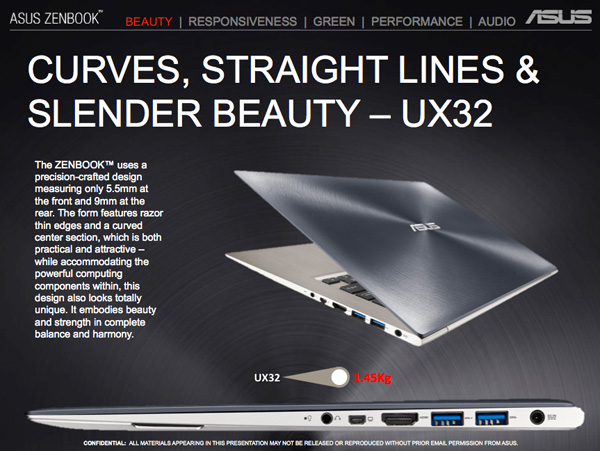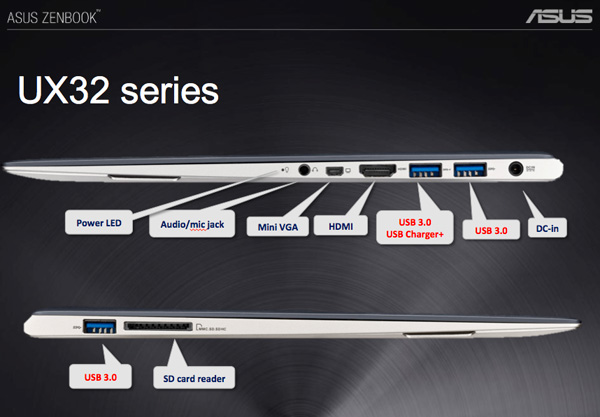ASUS Zenbook Prime (UX21A) Review: The First of the 2nd Gen Ultrabooks
by Anand Lal Shimpi on May 22, 2012 2:46 PM EST- Posted in
- Laptops
- CPUs
- Asus
- Ivy Bridge
- Zenbook
- Zenbook Prime
- Ultrabook
- Notebooks
The first round of Ultrabooks were mostly underwhelming. It shouldn't be a surprise, but many of the efforts were just half hearted at best. Of the companies who shipped the first Ultrabooks however, it was ASUS who came the closest to perfection with the Zenbook.
ASUS' Zenbook embodied the form factor, portability and overall concept of an Ultrabook. Where it failed to deliver was with its keyboard, display and, at least initially, with its trackpad. The first Zenbook was an amazing effort given the short period of time that it was conceived and developed in, but it was too rough around the edges.
Despite only being introduced 7 months ago, the Zenbook is old news. This is the Zenbook Prime:
The Zenbook Prime is ASUS' second generation Ultrabook, built around Ivy Bridge silicon. Unlike most silicon updates to notebooks however, the Zenbook Prime takes an almost Apple-like approach to renovating the tangibles rather than just relying on a faster chip to do the heavy lifting.
I don't know that I've ever seen a faster turn around on implementing reviewer and user feedback into a product. The Zenbook Prime fixes nearly every issue I had with the original Zenbook. From keyboard to display, it's all significantly better with the Zenbook Prime.
The circumstances around today's launch are a bit peculiar. Intel has an embargo in place on the as of yet unreleased Ivy Bridge CPUs, this applies to both notebooks and desktops. One such line of CPUs, the dual-core ultra-low-voltage Ivy Bridge parts that will find their way into many Ultrabooks, is covered by the aforementioned embargo. That embargo lifts at some point in the not too distant future, but ASUS wanted to have its review-ready hardware out the door and getting coverage before then. Why the urgency? It could have something to do with Apple's expected launch of updated MacBook Air and MacBook Pro systems. Rather than for Apple to get all the glory for being first, ASUS set some guidelines: we're allowed to talk about everything to do with the new Zenbook Primes, we just can't get into specifics on the CPU just yet. That's right, you won't read any model numbers, clock speeds or cache sizes here. Given what's already public about the ULV Ivy Bridge lineup I suspect this information isn't too hard to figure out if you're really motivated.

Zenbook Prime (left) vs. Zenbook (right)
The rest of the Zenbook Prime has nothing to do with Ivy Bridge. The form factor of the Zenbook Prime remains unchanged from its predecessor. Just like before we'll see two distinct models, an 11-inch (UX21) and 13-inch (UX31) in for review. With the lid closed, these two look identical to their Prime-less (composite numbered?) counterparts. ASUS sent the 11-inch Zenbook Prime in for review:
| ASUS Zenbook Prime Specs | |||||||||
| UX21A-DB5x | UX21A-DB7x | UX31A-DB51 | UX31A-DB52 | UX31A-DB71 | UX31A-DB72 | ||||
| CPU | ULV IVB | ULV IVB | ULV IVB | ULV IVB | ULV IVB | ULV IVB | |||
| GPU | HD 4000 | ||||||||
| Display | 11.6-inch 1920 x 1080 IPS | 13.3-inch 1920 x 1080 IPS | |||||||
| Memory | 4GB DDR3-1600 (on-board) | ||||||||
| Storage | 128GB U100 SSD | 128/256GB U100 SSD | 128GB U100 SSD | 256GB U100 SSD | |||||
| Wireless Connectivity | Intel Centrino N 6205, 802.11b/g/n 2.4/5GHz 2x2:2, Bluetooth 4.0 | ||||||||
| Battery | 35Wh | 50Wh | |||||||
| Camera | 720p front facing | ||||||||
| Audio | Bang and Olufsen ICEpower | ||||||||
| I/O | 2 x USB 3, 1x audio/mic, 1x microHDMI, 1x miniVGA | 2 x USB 3, 1 x audio/mic, 1 x microHDMI, 1 x miniVGA, 1 x SD Card reader | |||||||
| Dimensions | 299mm x 168.5mm x 3-9mm | 325mm x 223mm x 3-9mm | |||||||
| Weight | 1.1kg | 1.3kg | |||||||
| Price USD | TBD | TBD | $1099 | $1199 | $1499 | $1599 | |||
Pricing is still in the air as the Zenbook Prime won't be shipping until early June. I suspect much of how aggressive ASUS is on this front will depend on what Apple does in the coming weeks.
Introducing the UX32, Starting at $799
There's also a new member of the Zenbook Prime lineup, the 13-inch UX32. Featuring a thicker chassis, the UX32 will be offered as low as $799 with a 1366 x 768 TN panel, hard drive + SSD cache and as high as $1299 with a discrete NVIDIA GeForce GT 620M GPU:
| ASUS Zenbook Prime UX32 Specs | |||||||||
| UX32A-DB31 | UX32A-DB51 | UX32VD-DB71 | |||||||
| CPU | ULV IVB | ULV IVB | ULV IVB | ||||||
| GPU | HD 4000 | NVIDIA 620M + HD 4000 | |||||||
| Display | 13.3-inch 1366 x 768 TN | 13.3-inch 1920 x 1080 IPS | |||||||
| Memory | 2GB DDR3-1600 (on-board) + 2GB or 4GB SO-DIMM | ||||||||
| Storage | 7mm 320GB HDD + 24GB SSD (cache) | 7mm 500GB HDD + 24GB SSD (cache) | 7mm 500GB HDD + 24GB SSD (cache) | ||||||
| Wireless Connectivity | Intel Centrino N 6205, 802.11b/g/n 2.4/5GHz 2x2:2, Bluetooth 4.0 | ||||||||
| Battery | 48Wh | ||||||||
| Camera | 720p front facing | ||||||||
| Audio | Bang and Olufsen ICEpower | ||||||||
| I/O | 3 x USB 3, 1 x audio/mic, 1 x HDMI, 1 x miniVGA, 1 x SD card reader | ||||||||
| Dimensions | 325mm x 223mm x 5.5 - ~9mm | ||||||||
| Weight | 1.44kg | ||||||||
| Price USD | $799 | $999 | $1299 | ||||||
Depending on how well the SSD cache works, and how good the 1366 x 768 panel is, the $799 UX32A could be a very compelling system.













192 Comments
View All Comments
Impulses - Tuesday, May 22, 2012 - link
This is not even close to being a gaming laptop...maniac5999 - Tuesday, May 22, 2012 - link
Quick question, but how decent would the UX32 be at light gaming? (Civ5 on low, SC2 on medium, etc) I'm having some trouble pegging it's performance down, even with the help of Notebookcheck.tipoo - Wednesday, May 23, 2012 - link
The review says says 20 is acceptable for an ultramobile on a slow action game like D3, not that it's a killer gaming experience.ananduser - Wednesday, May 23, 2012 - link
If 20fps is acceptable then 720p resolution is acceptable as well.JarredWalton - Wednesday, May 23, 2012 - link
I've been poking around at Diablo III on another laptop today; to say that it's the greatest experience ever on Intel's HD 4000 would be a stretch, but it's not horrible either. It looks like the worst offender for poor performance on HD 4000 is the shadow setting; at low and 768p I got ~24 FPS for a test sequence, while a bump to 900p with most other detail options at "max" only dropped performance slightly. Turn on high shadows though and you're looking at a drop to about half the frame rate (or 1/3 lower with medium shadows).One thing you have to understand with regards to Diablo III and what constitutes acceptable performance is that it's not a twitch shooter, and the mouse cursor is separate from the frame rate. If you're very tolerant, you could even play with frame rates in the teens, but I'd suggest 20 FPS as the bare minimum. Civilization V is similar in this regard, and it's slow-paced (turn based) enough that even 10 FPS could be livable for some. It all depends on what you're willing to live with. Minimum detail and 768p in Diablo III does look pretty lousy, though -- particularly the lack of shadows, which is one of the biggest boosts to performance.
Now, if you've actually played the game on HD 4000 and want to contribute something to the discussion, that would be fine. Since it sounds like you've never played the game in the first place (at least not on moderate/low-end hardware), though, I'm not sure there's much point in you opining on how "20fps is NOT playable". For most other games, you would be correct, but for Diablo III you're just guessing...wrongly I might add. I played through a whole section with an average of 18FPS and found it acceptable for someone that's not hardcore. (Note that that was with most detail settings maxed at 900p.)
Now I need to go install it on Trinity and a couple other laptops to see how the experience compares. Oh, and FWIW, I'm not sure Diablo III is adding much to the gaming experience that's wildly improved from Diablo II, other than finally supporting higher resolutions. 12 years and this is what they have to show for it. Hmmm....
gorash - Tuesday, May 22, 2012 - link
Soo, ASUS has managed to ship a laptop with a 1080p IPS display without breaking the bank. Why couldn't the other manufacturers do the same?Reflex - Tuesday, May 22, 2012 - link
1) That is the first ultrabook I have ever considered to be interesting enough to consider buying, especially the 13.3" model with nV graphics/1080p LCD2) This is the first Asus laptop I'd consider owning, I've never been impressed with their build quality.
Really I wish it had 8GB as an option, just for longevity's sake(I tend to run a laptop a minimum of 5 years) but at 6GB its probably close enough. Very impressive and reasonably priced too. Want to see the build options and price on the 13.3" version.
Also, can the 24GB built in flash cash be used in conjunction with a hybrid HDD from Seagate? Or will that be an issue? What if you put in a SSD?
dagamer34 - Tuesday, May 22, 2012 - link
There's little point in double caching an SSD.Reflex - Wednesday, May 23, 2012 - link
Correct, but thats the thing, the cache is built in. What happens if you install a SSD? Does it get disabled?Also, there might be some point. This cache is SLC flash, if its utilized extensively it could extend the usable life of the installed SSD by preventing unnecessary writes...
sicofante - Thursday, May 24, 2012 - link
Wouldn't this take 8GB modules? That would make 10GB of RAM, which is pretty future proof for me.If it has 24GB built-in flash, I'd ask for a very big HDD, say 1TB? It would be cheaper than any SSD model and, with those 24GB acting as a cache, fast enough for everyday tasks. Do they offer such a combination?